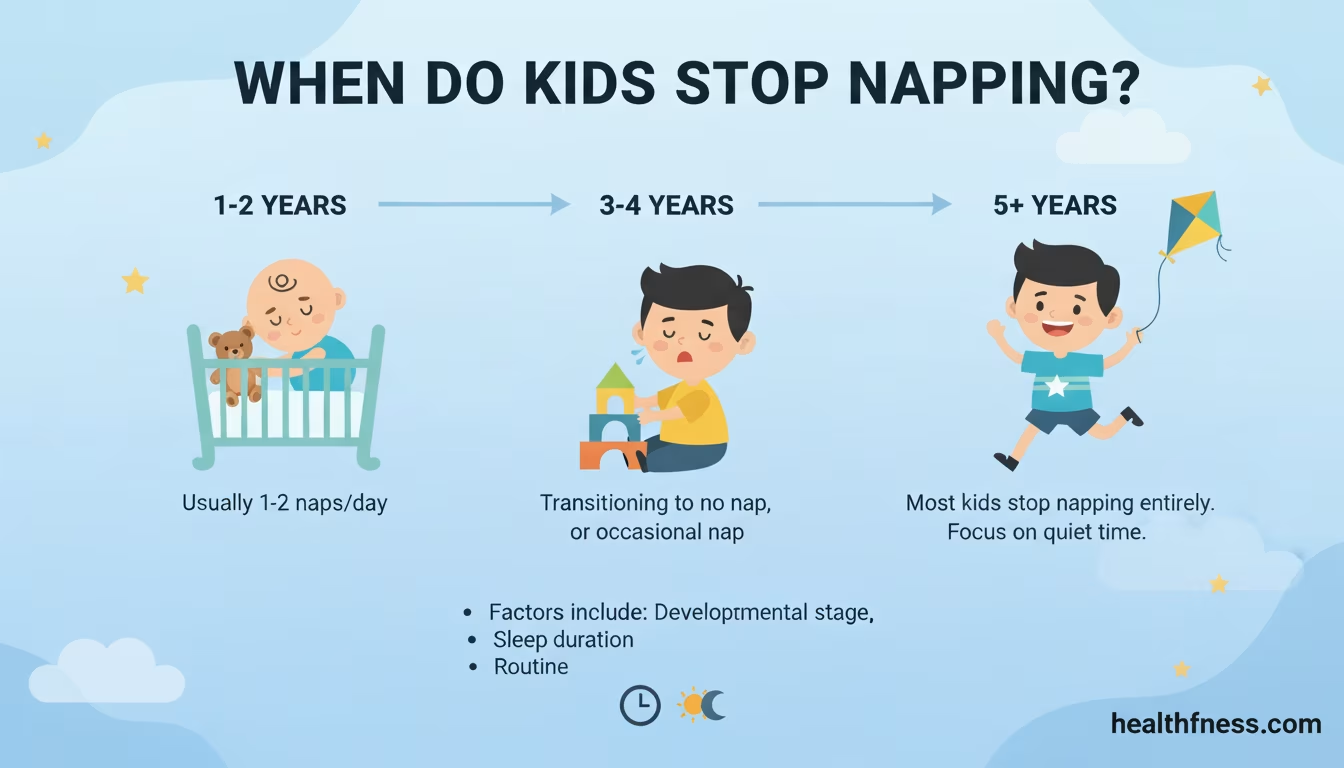As a parent, you’ve likely cherished your child’s nap time, that golden window of peace for catching up on chores, work, or simply your own rest. But then, the day comes when your energetic toddler decides nap time is playtime. You find yourself asking the big question: “Is this it? When do kids stop napping?”
Navigating the end of naps can be a confusing and often challenging phase. Dropping the nap too soon can lead to a cranky, overtired child, while continuing it for too long can wreak havoc on bedtime. This comprehensive guide is here to walk you through every step of the process. We’ll explore the science behind changing sleep needs, identify the clear signs your child is ready, and provide practical, expert-backed strategies to ensure a smooth transition for the whole family.
What is the Nap Transition? An Overview
The nap transition is the developmental stage when a child’s sleep patterns consolidate, and they no longer require daytime sleep to function well. Their bodies mature to the point where they can get all the restorative sleep they need during one long stretch at night. This isn’t an overnight switch but a gradual process that unfolds over weeks or even months.
While every child is unique, research provides a general timeline. Most children transition from two naps to one between 14 and 18 months of age. The final transition to no naps typically occurs between the ages of 3 and 5. A large-scale 2020 systematic review published in Sleep Medicine Reviews found that by age 5, more than 94% of children have stopped napping regularly.
It’s crucial to remember that age is just a guideline. A child’s individual temperament, activity level, and nighttime sleep quality are far more important indicators of their readiness to stop napping.
Why Napping Needs Change: The Science Behind the Transition
A child’s evolving sleep needs are deeply rooted in their brain development. Two primary biological processes drive the shift away from napping: the maturation of the circadian rhythm and the regulation of sleep pressure.
- Circadian Rhythm Maturation: The circadian rhythm is our internal 24-hour body clock, managed by a part of the brain called the suprachiasmatic nucleus (SCN). In infants and young toddlers, this internal clock is still developing, leading to fragmented sleep spread throughout the day and night. As a child grows, the SCN matures, strengthening the signals for a long, consolidated period of nighttime sleep and a long, consolidated period of daytime wakefulness.
- Sleep Pressure Regulation: Sleep pressure (or homeostatic sleep drive) is the natural urge to sleep that builds up the longer we are awake. A chemical called adenosine accumulates in the brain during waking hours, creating this pressure. In young children, this pressure builds very quickly, requiring one or more naps to release it. As they get older, their brains become more efficient at handling longer periods of wakefulness, allowing them to maintain alertness throughout the day and build enough sleep pressure for a full night’s sleep.
A 2022 study in the Proceedings of the National Academy of Sciences (PNAS) highlighted that this transition is closely linked to the development of the hippocampus, a brain region critical for memory. As the hippocampus matures, it becomes better at consolidating memories, reducing the reliance on naps for this cognitive function.
The Undeniable Benefits of Napping for Young Children
Before you rush to drop the nap, it’s essential to appreciate why it’s so beneficial. Naps are not just about giving parents a break; they are a cornerstone of early childhood development.
- Enhanced Learning and Memory: Naps play a vital role in memory consolidation. A 2021 study in Developmental Science found that naps help young children retain and recall new information, essentially acting as a “reboot” for the brain that solidifies learning from the morning.
- Improved Emotional Regulation: An overtired child is often an emotionally volatile one. Naps help regulate emotions by giving the brain a chance to rest and reset. Research shows that well-rested toddlers have better emotional control, fewer tantrums, and a more positive mood.
- Better Nighttime Sleep: It may seem counterintuitive, but a good nap can lead to better sleep at night. This is because it prevents a child from becoming overtired. An overtired child’s body releases stress hormones like cortisol and adrenaline, which can make it incredibly difficult for them to settle down and fall asleep at bedtime, leading to a frustrating cycle.
- Physical Health and Growth: Growth hormone is primarily released during deep sleep. Naps provide an additional window for this crucial hormone to be secreted, supporting healthy physical development.
Risks of Dropping the Nap Too Soon
Encouraging a child to stop napping before they are developmentally ready can have several negative consequences. Recognizing these risks can help you make a more informed decision.
- Chronic Overtiredness: This is the most significant risk. An overtired child doesn’t just get sleepy; they can become hyperactive, clumsy, irritable, and have difficulty focusing.
- Behavioral Challenges: A persistent lack of sleep can manifest as increased aggression, defiance, and frequent meltdowns, especially in the late afternoon and evening.
- Disrupted Nighttime Sleep: As mentioned, overtiredness can lead to difficulty falling asleep at bedtime, more frequent night wakings, and early morning wakings.
- Impact on Cognitive Function: A sleep-deprived brain struggles to learn and retain information, which can affect a child’s readiness for preschool and kindergarten.
5 Clear Signs Your Child is Ready to Stop Napping
So, how do you know for sure? Your child will give you consistent clues. Look for these five signs happening most days for at least two to three weeks before making a change.
- Consistently Resisting or Skipping Naps: The most obvious sign is when nap time becomes a daily battle. If your child plays, sings, or talks in their crib for an hour without showing any signs of sleepiness, they may no longer need the nap. This is different from a temporary “nap strike” that might last a few days during a developmental leap.
- Difficulty Falling Asleep at Bedtime: If a daytime nap is pushing bedtime later and later, it could be a sign that their total sleep needs are decreasing. If your child, who used to fall asleep at 7:30 PM, is now wide awake until 9:00 PM on nap days, it’s a strong indicator.
- Waking Up Very Early in the Morning: A long daytime nap can sometimes “steal” sleep from the night. If your child starts consistently waking for the day before 6:00 AM, and they are otherwise well-rested, their nap may be the culprit.
- Happy and Energetic on No-Nap Days: Pay close attention to their mood and energy on the occasional day they miss a nap. If they sail through the afternoon without meltdowns and aren’t falling apart by dinner time, their stamina is increasing.
- Sleeping Well Through the Night: A child who is ready to drop the nap is typically able to consolidate their sleep effectively at night, getting the 10-13 hours they need without frequent interruptions.
Conversely, 4 Signs Your Child Still Needs a Nap
It’s just as important to recognize when your child is not ready. If you see these signs, it’s best to keep offering a nap or quiet time.
- Late Afternoon Meltdowns: Is your child reasonably pleasant until about 4:00 PM, when they suddenly become extremely cranky, weepy, or irritable? This “witching hour” is a classic sign of overtiredness.
- Hyperactivity or “Wired” Behavior: Overtiredness in young children often looks like hyperactivity. If they seem to get a second wind of wild, frantic energy in the evening, it’s likely a sign they’ve missed their window for sleep.
- Falling Asleep on Short Car Rides: If a five-minute trip to the grocery store is enough to send your child into a deep sleep, their sleep pressure is very high, and they almost certainly still need a regular daytime nap.
- Increased Clumsiness or Inattentiveness: Sleep is critical for motor skills and focus. If you notice your child tripping more often or having a hard time paying attention to a simple task on no-nap days, their brain and body are feeling the strain.
Sleep and Nap Needs by Age: A Comparison
Understanding the average sleep requirements for different age groups can provide helpful context as you navigate this transition. These recommendations are based on guidelines from the American Academy of Sleep Medicine.
| Age Group | Recommended Total Sleep (in 24 hours) | Typical Number of Naps | Average Nap Duration |
|---|---|---|---|
| 1-2 Years | 11-14 hours | 1 | 1.5 – 3 hours |
| 2-3 Years | 11-14 hours | 1 (may start dropping toward age 3) | 1 – 2.5 hours |
| 3-5 Years | 10-13 hours | 0-1 (most drop the nap in this range) | 1 – 1.5 hours (if napping) |
| 6-12 Years | 9-12 hours | 0 (Naps are uncommon) | N/A |
Source: American Academy of Sleep Medicine (AASM), 2016.
How to Smoothly Transition Away From Naps: A Practical Guide
Once you’ve determined your child is truly ready, the key is to manage the transition gradually. Quitting “cold turkey” can backfire, leading to an exhausted child and frustrated parent.
Step 1: Gradually Shorten the Nap
Instead of eliminating the nap entirely, start by capping it. If your child normally naps for two hours, try waking them after 90 minutes. Do this for a few days. If bedtime improves, you can try shortening it further to 60 minutes, then 45, then 30. A short “power nap” can be just enough to get them through the day without ruining their night. Eventually, they may start refusing this shorter nap altogether, signaling the next step.
Step 2: Introduce “Quiet Time”
This is the single most effective strategy for dropping the last nap. Replace nap time with a mandatory “Quiet Time.” This maintains a period of rest in their day and gives them the autonomy to sleep if their body truly needs it.
- Keep the Routine: Start quiet time at the same time their nap used to be. Go through the same wind-down routine (e.g., read a book, close the curtains).
- Set Up a Safe Space: Quiet time should happen in their room, which must be fully childproofed. Ensure all furniture is anchored and any potential hazards are removed.
- Offer Quiet Activities: Provide a small selection of low-stimulation activities they can do independently in their bed or a cozy corner. Think books, puzzles, or mess-free coloring pads. Avoid screens or noisy electronic toys.
- Use a Visual Timer: An “OK to wake” clock or a simple visual timer is a game-changer. Set it for a short duration initially (e.g., 20-30 minutes) and explain that when the light turns green or the timer goes off, quiet time is over. Gradually increase the duration up to 60-90 minutes.
Step 3: Move Bedtime Earlier
This step is non-negotiable. On days your child doesn’t nap, you must compensate by moving their bedtime earlier to prevent overtiredness. A child who skips their nap may need to go to bed as early as 6:00 or 6:30 PM. This might seem incredibly early, but it’s essential for ensuring they still get the 10-13 hours of total sleep they need. Watch for their sleepy cues (yawning, rubbing eyes) and act on them immediately.
Step 4: Be Consistent but Flexible
The transition period can be bumpy. Some days your child may need a nap, and other days they won’t. This is normal. Continue to offer quiet time every day. If they fall asleep during quiet time, that’s okay! Simply note that bedtime might need to be a little later that night. If they are having a particularly busy day or are feeling unwell, they are more likely to need a nap. Flexibility is key to avoiding unnecessary battles.
Frequently Asked Questions (FAQs)
- What is the average age for a toddler to stop napping?
- The average age is between 3 and 4 years old. However, some children are ready as early as 2.5, while others may benefit from an occasional nap until age 5. Focus on your child’s individual signs of readiness rather than their age.
- My 2-year-old has stopped napping. Is this normal?
- While it’s on the early side, it’s not unheard of. Before officially dropping the nap, ensure it isn’t a temporary nap strike related to the 2-year sleep regression. If they are consistently happy, sleeping well at night (11+ hours), and not showing signs of being overtired for several weeks, they may simply have lower sleep needs. In this case, implement an early bedtime and quiet time.
- How can I tell if my child is overtired or just doesn’t need a nap?
- An overtired child will show signs of distress: crankiness, hyperactivity, emotional outbursts, and clumsiness, especially in the late afternoon. A child who is ready to drop the nap will be generally cheerful and able to function well throughout the day without these signs of fatigue.
- What do I do if my child falls asleep in the car in the late afternoon?
- The late afternoon car nap can be a bedtime-wrecker. If possible, try to avoid car trips during their tiredest time of day. If it’s unavoidable and they do fall asleep, keep the nap very short (wake them after 15-20 minutes) and expect that bedtime will need to be pushed later that night.
- Should I let my child nap if it makes bedtime a battle?
- If a nap consistently leads to a very late and difficult bedtime, it is a strong sign they are ready to transition. Start by shortening the nap significantly. If a short 30-minute nap still causes a 9:00 PM bedtime, it is likely time to replace the nap with quiet time and an earlier bedtime.
- How long should “quiet time” last?
- Aim for 60 to 90 minutes. Start with a shorter duration, like 20-30 minutes, and gradually increase it as your child gets used to the routine. This provides a truly restorative break for them and for you.
- My child naps at daycare but refuses to nap at home on weekends. What should I do?
- This is very common. The environment at daycare is stimulating, and many children nap there out of necessity. On weekends, they may not be as tired. On these no-nap weekend days, enforce a quiet time and move bedtime earlier. Don’t worry about the inconsistency; many children adapt well to this hybrid schedule.
Conclusion
The end of napping marks a significant milestone in your child’s development, they are officially a “big kid.” While it can be a bittersweet transition for parents who will miss that midday break, understanding the signs and managing the process thoughtfully can make it a positive experience. Remember the golden rules: watch for consistent cues of readiness over several weeks, transition gradually by shortening naps and introducing quiet time, and always prioritize an earlier bedtime on no-nap days. Above all, trust your instincts. You are the expert on your child, and by paying close attention to their needs, you can confidently guide them through this change and ensure they continue to get the healthy sleep they need to thrive.
References
- Staton, S. L., Smith, S. S., & Thorpe, K. J. (2020). Many naps, one nap, none: A systematic review and meta-analysis of napping patterns in 0-12 years. Sleep Medicine Reviews, 53, 101341.
- Spencer, R. M. C., & Riggins, T. (2022). Contributions of memory and brain development to the bioregulation of naps and nap transitions in early childhood. Proceedings of the National Academy of Sciences, 119(44), e2123415119.
- Lokhandwala, S., & Spencer, R. M. C. (2021). Slow wave sleep in naps supports episodic memories in early childhood. Developmental Science, 24(2), e13031.
- Paruthi, S., Brooks, L. J., D’Ambrosio, C., Hall, W. A., Kotagal, S., Lloyd, R. M., … & Wise, M. S. (2016). Recommended amount of sleep for pediatric populations: a consensus statement of the American Academy of Sleep Medicine. Journal of Clinical Sleep Medicine, 12(6), 785-786.
- Weissbluth, M. (1995). Naps in Children: 6 Months–7 Years. Sleep, 18(2), 82–87.

Dr. Mark Jenkins, MD - General Physician (California, USA)
Dr. Mark Jenkins is a board-certified general physician based in the United States, specializing in preventive medicine, nutrition, and lifestyle health. With years of clinical experience in primary care, he is dedicated to helping patients and readers alike make informed, science-based decisions about their well-being.
As a trusted medical reviewer and contributor to Healthfness.com, Dr. Jenkins ensures that all health content meets the highest standards of accuracy, safety, and evidence-based medicine. His expertise bridges modern medical science with practical, everyday wellness strategies, making complex topics approachable for all audiences.
Outside the clinic, Dr. Jenkins is passionate about living the healthy lifestyle he teaches. He enjoys hiking with his dog, experimenting with vegetarian cooking, and exploring the latest health research. He believes that small, consistent lifestyle changes lead to lasting health improvements, and he aims to inspire readers to take proactive steps toward a healthier, happier life.
Explore more of Dr. Jenkins’ evidence-based insights at Healthfness.com



